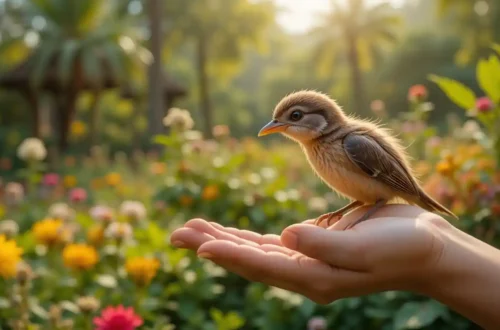The Birds Nest Fern Plant, scientifically known as Asplenium nidus, is a captivating and low-maintenance houseplant that has gained popularity in Indian homes and offices. Its lush, rosette-shaped leaves add a touch of tropical elegance to any space, making it a favorite among plant enthusiasts in India. Whether you live in the tropical regions of southern India or the subtropical areas of northern India, the Bird Nest Fern Plant can thrive with proper care.
Why Choose Bird Nest Fern Plant for Indian Gardens?
In India, where the climate varies significantly from region to region, the Birds Nest Fern Plant is an ideal choice for both indoor and outdoor spaces. It adapts well to low-light conditions, making it perfect for homes and offices with limited natural light, which is common in many Indian cities. Additionally, its low-maintenance requirements make it accessible to both novice and experienced gardeners across India.
Cultural Significance of Bird Nest Fern Plant in India
In Indian culture, plants like the Birds Nest Fern Plant are often valued for their aesthetic appeal and spiritual significance. According to Feng Shui and Vastu Shastra, the Birds Nest Fern Plant is believed to attract positive energy and prosperity, making it a popular choice for living rooms and workspaces in Indian homes. This plant is associated with the wood element, representing growth and vitality, which aligns well with Indian beliefs about the importance of nature in daily life.
Growing Conditions for Birds Nest Fern Plant in India
To grow a healthy Bird Nest Fern Plant in India, you need to replicate its natural habitat. It thrives in temperatures between 18°C and 32°C, which is typical of many Indian regions. The plant requires bright, indirect sunlight, making an east or north-facing window ideal for placement. In regions like Kerala or Tamil Nadu, where humidity is naturally high, the Birds Nest Fern Plant will flourish without additional humidification. However, in drier regions like Delhi or Rajasthan, using a humidity tray can help maintain the optimal environment.
Care and Maintenance Tips for Bird Nest Fern Plant
Caring for a Bird Nest Fern Plant in India is relatively straightforward:
- Lighting: Place the plant in a spot with bright, indirect sunlight. Direct sunlight can scorch the leaves, so it’s best to avoid south-facing windows.
- Watering: Keep the soil consistently moist but not soggy. Watering once or twice a week is usually sufficient, depending on the humidity and temperature of your location in India.
- Humidity: Maintain high humidity levels, especially in drier regions of India. Regular misting or using a humidity tray can help.
- Temperature: Ensure the plant is kept in a room with a stable temperature between 18°C and 32°C.
- Fertilization: Use a balanced liquid fertilizer every 2-4 weeks during the growing season (spring and summer).
Common Challenges in Growing Birds Nest Fern Plant in India
Despite its hardiness, the Bird Nest Fern Plant can face challenges in Indian conditions:
- Pests: Scale insects, mealybugs, and spider mites can infest the plant. Regular inspection and using organic pest control methods can help manage these issues.
- Diseases: Overwatering can lead to root rot. Ensure the pot has good drainage holes and avoid watering directly into the “nest” of the plant.
- Environmental Issues: Low humidity and extreme temperatures can cause leaf damage. Adjusting the environment or relocating the plant can mitigate these problems.
Propagation Methods for Birds Nest Fern Plant
Propagating a Bird Nest Fern Plant involves dividing the plant or using spores. Division is more straightforward and can be done when repotting the plant every 1-2 years. Spore propagation is more challenging and typically requires specialized conditions.

Decorative Uses of Birds Nest Fern Plant in Indian Homes
The Birds Nest Fern Plant is versatile and can enhance any room in an Indian home:
- Living Room: Place it as a centerpiece or in a decorative pot to add a touch of elegance.
- Bedroom: Its calming presence can promote better sleep when placed in a corner or on a nightstand.
- Office: Ideal for workspaces due to its low-maintenance requirements and ability to thrive in low-light conditions.
- Bathroom: The higher humidity in bathrooms makes them an excellent location for this plant.
Benefits of Having Birds Nest Fern Plant in Your Home
In addition to its aesthetic appeal, the Birds Nest Fern Plant offers several benefits for Indian homes:
- Air Purification: It acts as a natural air filter, absorbing pollutants and releasing oxygen.
- Biophilic Benefits: Incorporating nature into your home can reduce stress and improve mental well-being.
- Feng Shui and Vastu Shastra: Believed to attract positive energy and prosperity, making it a popular choice for those following these principles.
Conclusion:
The Bird Nest Fern Plant is a wonderful addition to any Indian garden or indoor space. Its unique appearance, low-maintenance requirements, and numerous benefits make it a must-have for plant enthusiasts across India. Whether you live in the humid climates of Assam or the drier regions of Gujarat, with proper care, the Birds Nest Fern Plant can thrive and bring a touch of tropical beauty to your home.
Additional Tips for Indian Gardeners
For those looking to integrate the Birds Nest Fern Plant into their gardening practices in India, here are some additional tips:
- Soil: Use a well-draining, peat-based potting mix to ensure optimal growth.
- Repotting: Repot the plant every 1-2 years to provide fresh soil and a slightly larger pot if necessary.
- Pest Control: Regularly inspect the plant for pests and use organic methods to manage infestations.
Regional Variations and Adaptations
In different regions of India, the Birds Nest Fern Plant may require slight adjustments in care:
- Tropical Regions: In areas like Kerala or Goa, the plant will thrive with minimal additional care due to the naturally high humidity.
- Subtropical Regions: In regions like Delhi or Punjab, maintaining higher humidity levels through misting or a humidity tray is crucial.
By following these guidelines and tips, you can enjoy the beauty and benefits of the Birds Nest Fern Plant in your Indian home or garden.






